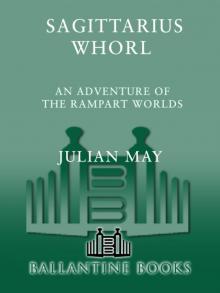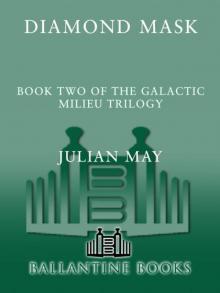- Home
- Julian May
Diamond Mask Page 4
Diamond Mask Read online
Page 4
When Jack the Bodiless began his test, the image of the newly modified SIE tree with its baroque ornaments seemed to glow within its bath of artificial cerebrospinal fluid. Responding to Jack’s initiation command, the single unit triggered a complex flood of mind-boosting neurosecretions to a model operator-brain roughly equal in mental assay to that of a grandmasterclass operant. For a few seconds, the executive processor let the new cerebroenergetic enhancement “cook,” activating certain portions of the cerebral cortex that were ordinarily unused. Then the SIECOMEX phased in the equivalent of 25 additional SIE units also having the modification. At this point Jack commanded the fully equipped brain simulation to evaluate itself in the metacreativity mode, and the most critical part of the test began.
Marc said: Neurometrics looking good mondingofrelot damngood.
Jack said: Limbics okay this time both hemispheres syncing on creative parameters feedback beautiful I’m going to ask for the overall evaluation now Marco letusPRAY!!
The holodisplay changed abruptly to a flickering mass of graphical analysis that almost defied Marc’s ability to keep up with it. In less than six minutes, the analyzer simulated an hour of CE equipment use by a metapsychic operant of high mental status. While there was increasing minor dysfunction in certain areas, the psychoresultant showed an upgrade in creative metafaculty output somewhat greater than Jack had originally anticipated.
IT WORKS! shrieked the enraptured boy-mind.
“Yes,” Marc said. “It certainly does. In theory.” He watched the continuing simulation for some time with a slight, one-sided smile. Then he reached out and shut down the machine. “The new design is practicable and all I have to do is build it and tune it and test it on a meat-brain.”
How long do you think that’ll take?
Marc shrugged. “Seven months—maybe less. I’ll be the guinea pig, of course.”
ME TOO pleaseMarcoPLEASE—
“Don’t be silly. You can help with the helmet design work in your spare time, but that’s all. Testing this new rig will be dangerous and expensive, and there are also tricky political considerations that’ll need juggling. The college administrators are getting more and more antsy about the project.”
But—
“Don’t argue! You’re only a kid, Jack. A brilliant and talented and bizarro kid—but in the eyes of the law and of Dartmouth College you have no business messing around with hazardous equipment. Now put yourself back together again and let’s get the hell out of here.”
Fury paid no attention as Jack the Bodiless reassumed his former aspect of a ten-year-old child. Jubilant at what it had just witnessed, the monster had already abolished its presence in the laboratory and was soaring eastward over the Atlantic Ocean toward the British Isles, indulging in delicious speculation.
Until now, the practical applications of cerebroenergetics had been relatively prosaic, and not particularly useful to Fury. For over half a century, simple CE devices had been used for recreational romps in various virtual-reality environments; but the potentially addictive amusements were now hedged about with legal restrictions and forbidden to children altogether, while CE equipment incorporating more elaborate technology was widely utilized, even by normals, for specialized education and for operating sophisticated machinery.
CE augmentation of the metapsychic functions was still in its infancy, however. It was a uniquely human endeavor that the five other races of the Milieu viewed with both awe and misgiving. Exotic critics judged the new technology to be just one more way for upstart humanity to endanger the stability of the Galactic Mind.
Redactive CE was sometimes used by operants performing delicate psychosurgery or retroevolutionary genetic engineering. Psychokinetic boosting had been applied to macromolecular synthesis and complex nanotechnology such as the building of elaborate electronic, photonic, or bionic flecks. Lately, even more powerful “barber-chair” CE requiring life support as well as brain implantation had been used to boost the mental capacity of PK operants working on subatomic projects. Similar equipment, potentially very hazardous to the operator, had been used by farsensory adepts probing the gray limbo of hyperspace in search of experimental evidence for the three hypothetical “matrix fields” that were believed to form the ultimate basis of reality.
Significant augmenting of the creative metafunction, the higher mindpower that might theoretically have the greatest impact upon the physical universe, was thought by many Milieu authorities to be of dubious potential, not only because of the inherently grave risk to the mind utilizing the technology, but also on account of the danger of misapplication.
The latter, of course, was what most intrigued Fury.
Marc Remillard had no doubts whatsoever about the practicability of creativity enhancement. He had experimented with different types of brain-boosting for years, and he persisted with his research into the far frontiers of creativity magnification when more conservative workers in the CE field held back. His work was given academic respectability under the aegis of Dartmouth College, and the papers he published were acknowledged to be brilliant. But certain powerful faculty members of the Department of Metapsychology had objected strenuously to the E15 project on ethical grounds, also intimating that young Professor Marc Remillard was arrogant, high-handed, contemptuous of his more prudent colleagues, and insufficiently sensitive to the metapsychic Pandora’s box his work might open.
Marc pooh-poohed the timidity of his critics while loftily ignoring slights to his character. Greatly enhanced creativity was not for every mind, that went without saying. In his opinion, only the most powerful grandmasterclass operants of proven mental stability were suitable candidates. As for the ethical questions, he maintained that they could be confronted and dealt with once the E15 equipment was operable, at the time that individual CE creativity projects were proposed. It was the misuse of the technology, not the technology itself, that might be adjudged immoral. Application guidelines should be and would be developed for creativity augmentation, just as they had been developed for nuclear energy and even for metafunction itself, which had posed similar ethical problems.
When Jack the Bodiless became secretly involved in the experiments of his elder brother, he confessed that he was seriously concerned about the moral dilemma; but he was only a child, after all, with limited experience in matters of good and evil in spite of his towering intellect. Marc’s arguments in favor of the E15 research had been very persuasive.
It had taken the two strangely compatible colleagues a little over a year to proceed from bare-bones theory to this monumental breakthrough. Beyond a doubt they would now continue to work together unofficially, attaining even greater success in times to come.
Fury was quite proud of the brothers, even though they were flawed and unlovable. All unawares they had furthered the monster’s grand scheme.
If only Fury could have used the new CE technology itself! But that was a fundamental impossibility, since the entity presently lacked a genuine physical presence, being even less substantial than the Lylmik. It was Fury’s Hydra component, tucked away in a safe corner of Earth for a number of years while slowly maturing, that would be the proper beneficiary of creativity enhancement.
Wearing this new E15 helmet, even nonoperants might find their natural creative gifts producing novel inventions, worthy artwork, or spectacular stratagems for altruism or villainy—provided that the brain of the operator was strong enough to withstand the device’s potential. A metapsychic possessing strong natural creativity, as the Hydra-units did, would be able to accomplish deeds that normal humans would deem godlike: complex material synthesis; geophysical alteration; massive ionic accumulation, discharge, and control. Transforming matter into directed energy would be child’s play to such an operator, who would command the equivalent of a gigawatt mental laser.
The Hydra would eventually have to increase and multiply in order to take full advantage of the breakthrough, but that was also part of Fury’s great plan. After sui
table training, the CE-equipped creature, acting in metaconcert with Fury, need utilize no other weapons save its augmented multiplex brain in order to destroy the present galactic confederation and establish a Second Milieu …
Provided that this new E15 technology was not suppressed by meddling regulatory officials, to die aborning.
The Scottish threat to Marc’s project, the nearly completed adverse statistical report on long-term CE operator safety that would very likely bring all human creativity-boosting research to an abrupt halt, must now be neutralized without delay.
Obliterating the data was not the answer. The Edinburgh team would simply reconstruct it. There was only one way to make certain that Marc’s project was not endangered: all three of the Scottish researchers would have to die. And Hydra, Fury’s creature and its only safe link to the matter/energy-space/time lattices, was the only one who could do the job.
Taking out three masterclass metapsychics without a trace was well within the Hydra’s competence; but it would still be a tricky operation, especially if it was done in the environs of the University of Edinburgh, that teeming hive of leery and powerful Celtic operants. A misstep (the Hydra-units were still very young and overconfident, and some sort of cock-up was all too likely) and the creature itself might be imperiled.
That would be totally unacceptable. Fury was severely limited in the physical sphere without Hydra, and its work was further complicated by periods of enforced dormancy. As a matter of fact, the present window of activity was about to close, and soon Fury would have to withdraw; but there was time yet to see Hydra on the track of its prey.
Clever, precious Hydra! The units were twenty-two years of age now, and while they had not stinted in supplying themselves with their primary source of mental nourishment, the killings had been done at decent intervals with admirable ingenuity. No suspicion had ever fallen upon the four disguised entities. The Hydra now was well educated, polished to a reasonably sophisticated luster, and very nearly ready to operate in the arena of the Galactic Milieu.
This particular executive action would be good training for similar exercises in the future. The three Scottish researchers would have to be lured out of their sanctuary at the university, then eliminated without a trace. Once they were gone and their data destroyed, Marc would face no significant opposition to his project. No other CE safety-study groups on Earth or on human colonial planets posed any imminent danger.
The monster hovered above the British Isles for some time, studying various aspects of the situation together with the dramatis personae involved. Then at last it called.
Fury? … FuryFurydearestFury is it YOU after allthistime?
But what happened not single word from you not a farsqueak for more than 3years!
But Godalmighty 3years 3friggingyears I thought you’d forgotten ME/us thought your grandscheme was ruined thought the Great-Enemy might have won thought UncleFred/you might really have died—
!!Tell ME/us!!
INNER HEBRIDES, SCOTLAND, EARTH, 25–26 MAY 2062
DURING THE BRIEF RHOCRAFT FLIGHT FROM EDINBURGH TO THE west coast of Scotland, the five-year-old child who called herself Dee studied the durofilm sea chart that Gran Masha had given her. They were going to travel to their holiday destination in a very special way—not in an ordinary inertialess egg-bus but on an old-fashioned ferryboat nearly a hundred years old.
From the air, the boat looked like a strange toy, its contours dimmed by mist; but then the egg landed at the dockside pad and Dee and the others disembarked and were able to see the ancient vessel closely. It was huge, looming there in the drizzle, as unlike the small pleasure boats of Granton Harbour near Dee’s home as Edinburgh Castle is unlike a regular townhouse. The ferry had a scarlet funnel and a black-and-white hull and an earsplitting whistle that echoed from shore to shore in the rainswept narrow sea-loch. It seemed to urge those on shore to get aboard quickly or be left behind.
Mummie took one of Dee’s hands and Aunt Rowan took the other. Loudspeakers on the ferry broadcast an eerie bagpipe melody as they went up the gangplank. Tall, imposing Gran Masha in her smart green tweed walking suit led the way, towing Dee’s brother Ken, and Uncle Robbie brought up the rear carrying their bags.
“This is weird,” Ken said, as they all arrived on the wet and windy deck. Pennants were flapping, passengers in raingear were laughing and taking pictures, and a ship’s officer was directing people to move along. “Maybe,” the boy added, “we’ll have a good time on this holiday after all.”
“An inquiring mind,” said Mummie tartly, “will find things to enjoy no matter what place it finds itself in.”
“It’s going to be fun,” Gran Masha declared. She gave Ken’s hand an encouraging squeeze and smiled at Dee, who cringed as the ferryboat whistle gave another deafening hoot. Then the gangplank rose, the mooring lines were cast off, and they were on their way.
Groundcars bound for the Western Isles had been driven up a ramp into the hold and abandoned there; but the humans and the handful of exotic tourists making the voyage rode in the upper part of the ferryboat, where there were places to eat, and places to sit and look out of the windows at the gray sea, and a game room, and a souvenir store, and even tiny cabins to sleep in if you were traveling to one of the Outer Hebrides that were depicted on Dee’s chart, all connected to each other and to the Inner Hebrides and to the mainland of Scotland by a web of red lines that signified the Vee-routes of the egg transports. Only a handful of the Western Isles were served by the picturesque old ferries, whose routes were shown by black dots.
One of those islands was Islay.
By the time Dee and Ken finished exploring the vessel with Uncle Robbie and rejoined the three women, who had settled down with coffee in the spacious forward saloon, the ferryboat had come to the end of the protected waters of West Loch Tarbert and entered the rough open sea. The deck began to tilt in an alarming fashion, huge waves rolled past like gray mountains on the march, and the Scottish mist changed to heavy rain that splattered the saloon windows as though a giant hose had been turned on.
Ken thought that was exciting. “Maybe this big old tub will sink, and we’ll get to ride in the lifeboats!”
“The ferry will not sink,” Mummie said firmly. “Don’t be ridiculous, Kenneth.”
Dee was terrified that her older brother might be right. Gripping the arm of a seat to keep from losing her balance, she felt her stomach give an ominous leap. She took a deep breath and commanded it to stop that. No one must suspect how frightened she was!
Ken asked how long the trip would take. “Only two hours,” said Robert Strachan. “It’s about fifty kloms from the terminal at Kennacraig to Port Askaig on the eastern shore of Islay where we’ll be landing.”
“I hope the rain lets up soon,” Rowan Grant murmured. Like her husband, she wore a rain-resistant grintlaskin sportsuit. Hers was wine-colored and his was royal blue with white stripes up the arms and legs. Petite Viola Strachan was more elegantly dressed in gray woolen slacks, a black silk blouse, and a repelvel Burberry.
“The forecast promises fair skies by this afternoon,” said Masha.
“I still wish we’d gone to the Elizabethan Immersive Pageant,” Ken said. But his mother cut him off, handing him a credit card.
“That’s quite enough, Kenneth.
You and Dody may go and get something to eat if you wish. Or find someplace to sit and read the guide-plaques you brought. We grownups have some academic matters to discuss in private.”
“Oh, boy! Food! Come on, Dee!”
Ken went lurching off happily, but Dee felt much too queasy to eat. Her stomach was not obeying her order to behave itself and she was becoming dizzy as well. Fortunately, Mummie and the others never noticed her distress. She was very glad of that. It would be inconsiderate to bother them when they wanted to talk about really important things. While her brother headed for the ferry snack bar, she crept away to the other side of the passenger saloon and huddled alone in a leather seat. She had with her a small plaque with two book flecks installed, one a descriptive guide of the island and the other entitled Birds in Islay, with an electronic notebook for entering species observed. She loved birds, especially the bold merlins and kestrels and peregrines that were common in the countryside around Edinburgh. Gran Masha had said that they might catch sight of a sea eagle on Islay, and there would surely be many other interesting birds to look at—razorbills, puffins, and fierce skuas.

 The Many-Coloured Land
The Many-Coloured Land Conqueror's Moon
Conqueror's Moon The Sagittarius Whorl
The Sagittarius Whorl The Nonborn King
The Nonborn King Sky Trillium
Sky Trillium The Sagittarius Whorl: Book Three of the Rampart Worlds Trilogy
The Sagittarius Whorl: Book Three of the Rampart Worlds Trilogy Intervention
Intervention Orion Arm
Orion Arm Diamond Mask
Diamond Mask The Golden Torc
The Golden Torc The Noborn King
The Noborn King Magnificat
Magnificat Jack the Bodiless
Jack the Bodiless Perseus Spur
Perseus Spur The Adversary
The Adversary Sorcerer's Moon
Sorcerer's Moon Sagittarius Whorl
Sagittarius Whorl The Intervention (Omnibus)
The Intervention (Omnibus) Magnificat (Galactic Milieu Trilogy)
Magnificat (Galactic Milieu Trilogy) Jack the Bodiless (Galactic Milieu Trilogy)
Jack the Bodiless (Galactic Milieu Trilogy) Diamond Mask (Galactic Milieu Trilogy)
Diamond Mask (Galactic Milieu Trilogy) The Many-Coloured Land sope-1
The Many-Coloured Land sope-1